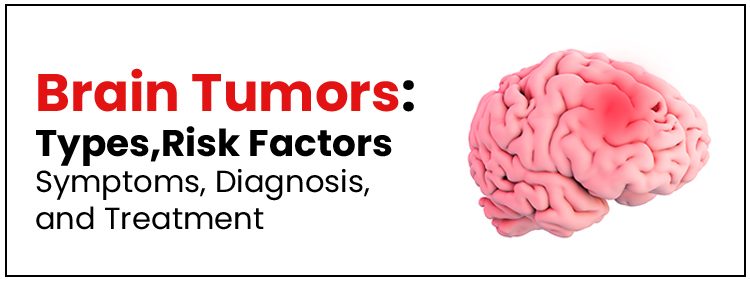
June 30, 2025
Beat Constipation with Simple Lifestyle Changes
June 30, 2023 - admin

A brain tumor refers to an abnormal cluster or mass of cells that develop within or near the brain. These tumors can occur in the brain tissue itself or in adjacent areas such as the pituitary gland, pineal gland, or the membranes covering the brain's surface. It's important to note that brain tumors can be categorized as benign, known as (non-cancerous) or malignant, known as (cancerous).
In the medical term, brain tumors are divided into two main types: primary and secondary. Primary brain tumors originate within the brain, while secondary brain tumors, also known as metastatic brain tumors, begin in another part of the body and spread to the brain.
Gliomas are the most prevalent type of brain tumor originating from glial cells, providing support and insulation to neurons. They include astrocytomas, oligodendrogliomas, and ependymomas. Glioblastoma multiforme (GBM) is a particularly aggressive and malignant form of glioma.
Meningiomas develop in the meninges, the protective membranes surrounding the brain and spinal cord. They are usually benign but can cause symptoms if they grow in size or press against vital brain structures.
These tumors form in the pituitary gland, a pea-sized gland which is present at the base of the brain. Pituitary adenomas are typically benign and can cause hormonal imbalances by producing excessive or insufficient hormones.
Medulloblastomas primarily affect children and arise in the cerebellum, the region responsible for motor coordination. They are fast-growing tumors and can spread to other parts of the central nervous system.
Schwannomas develop from Schwann cells, which produce the protective covering (myelin) around peripheral nerves. They commonly occur on the vestibular nerve, leading to symptoms such as hearing loss and balance problems.
Craniopharyngiomas are rare tumors that form near the pituitary gland and hypothalamus. They often affect children and can cause hormonal imbalances and vision problems.
Brain tumors can happen at any age, they are more common in older adults. Certain types are prevalent in specific age groups, with some predominantly affecting adults and others primarily occurring in children.
Brain tumor incidence varies among different racial groups. For instance, gliomas are more frequently diagnosed in individuals of white people, whereas meningiomas are more prevalent in Black people.
People exposed to a strong type of radiation have an increased risk of brain tumors. This strong radiation is called ionizing radiation. The radiation is strong enough to cause DNA changes in the body's cells. The DNA changes can lead to tumors and cancers. Ionizing radiation is a kind of radiation therapy which is used to treat cancer and radiation exposure caused by atomic bombs.
Low-level radiation from everyday objects isn't linked to brain tumors. Low radiation levels include the energy that comes from cell phones and radio waves. There is no convincing evidence that using cell phones causes brain tumors. But more studies are happening to make sure.
Inherited syndromes associated with specific DNA changes can heighten the risk of brain tumors. Conditions such as neurofibromatosis 1 and 2, tuberous sclerosis, Lynch syndrome, Li-Fraumeni syndrome, Von Hippel-Lindau disease, familial adenomatous polyposis, Cowden syndrome, and Gorlin syndrome can increase susceptibility to brain tumors.
Brain tumor symptoms depend on the location, size & type of the tumor. Some tumors cause direct damage by invading brain tissue, and others cause pressure on the surrounding brain.
You’ll have noticeable symptoms when a growing tumor pressures your brain tissue.
Headaches are the most common symptom of brain tumors. You may experience headaches that:
1. Are worse in the morning when waking up
2. Occur while you’re sleeping
3. Are made worse by coughing, sneezing, or exercise
Unexplained seizures, especially if they occur in adulthood without a prior history, may indicate the presence of a brain tumor. Seizures can manifest as convulsions, muscle jerking, or loss of consciousness.
Brain tumors can cause a range of neurological symptoms, including:
1. Changes in vision, such as blurred vision, double vision, or loss of peripheral vision.
2. Difficulty speaking or understanding speech.
3. Weakness or numbness in the limbs, often on one side of the body.
4. Balance and coordination problems, leading to instability and difficulty walking.
5. Memory problems, confusion, or personality changes.
Unexplained nausea and vomiting, particularly when not associated with digestive issues, may indicate increased intracranial pressure caused by a brain tumor.
Brain tumors can impact cognitive function, leading to memory problems, difficulty concentrating, and changes in behavior, mood, or personality.
Persistent fatigue, drowsiness, or sleep disturbances, such as insomnia or excessive sleepiness, can indicate a brain tumor.
When it comes to diagnosing a brain tumor, it requires a thorough evaluation by specialized healthcare professionals in neurology and neurosurgery. The diagnosis typically involves the following steps:
A healthcare provider will discuss your medical history and inquire about any symptoms you may be experiencing. They will also conduct a detailed physical examination, focusing on neurological function and looking for any signs of abnormalities.
This evaluation aims to assess the function of your brain and nervous system. It may involve tests to check your reflexes, coordination, muscle strength, sensation, and cognitive abilities.
Imaging plays a vital role in diagnosing brain tumors. Common imaging tests include:
This non-invasive procedure uses magnetic fields and radio waves to create detailed brain images. It helps determine the size, location, and characteristics of the tumor.
This imaging technique utilizes X-rays to produce cross-sectional brain images. It helps identify abnormalities and provides information about the shape and density of the tumor.
Sometimes, a biopsy is needed to confirm the diagnosis. A small tumor tissue sample is examined under a microscope during a biopsy. This procedure helps identify the type of tumor, its grade, and whether it is benign or malignant.
Blood and other laboratory tests may be conducted to assess general health, check organ function, and rule out other possible causes of symptoms.
Genetic tests might be recommended to identify specific genetic mutations or markers associated with certain types of brain tumors. This information can assist in treatment decisions and provide insights into prognosis.
The treatment of brain tumors depends on various factors, including the type, size, location, and grade of the tumor, as well as the patient's overall health and preferences. The primary treatment options for brain tumors include:
Surgery aims to remove the tumor as much as possible while preserving healthy brain tissue. The extent of tumor removal depends on factors such as tumor size, location, and accessibility. In some cases, surgery may not be feasible if the tumor is in a critical or inaccessible area of the brain.
Radiation therapy uses high-energy X-rays or other forms of radiation to target and destroy tumor cells. It can be administered externally (external beam radiation) or internally (brachytherapy). Radiation therapy may be used before or after surgery or as the primary treatment for inoperable tumors.
Chemotherapy involves the use of powerful medications to kill or slow the growth of cancer cells. It can be administered orally or intravenously. Chemotherapy may be used as an adjuvant therapy after surgery or combined with radiation therapy in certain cases.
Targeted therapy uses drugs that specifically target specific molecules or genetic abnormalities in cancer cells, disrupting their growth and survival. These therapies are tailored to the individual characteristics of the tumor, providing a more personalized approach to treatment.
Immunotherapy utilizes the body's immune system to recognize and attack cancer cells. It can enhance the immune response against brain tumors, potentially improving treatment outcomes.
Supportive care focuses on managing symptoms and enhancing the overall well-being of the patient. It may include pain management, physical therapy, occupational therapy, speech therapy, and psychological support.
The treatment approach is often multidisciplinary, involving a team of healthcare professionals, including neurosurgeons, neuro-oncologists, radiation oncologists, and specialized nurses. They work together to develop an individualized treatment plan tailored to the patient's specific needs and circumstances. Regular follow-up visits and imaging studies are conducted to monitor the response to treatment and make any necessary adjustments.
Tags:


Leave a comment